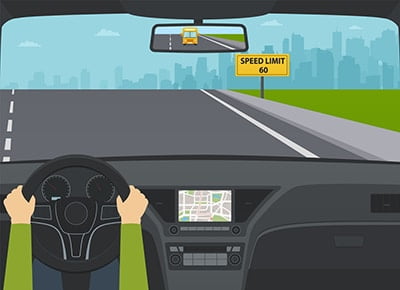Quiz: Obey speed limits
Reading the MTO Driver’s handbook is a rite of passage when preparing for the Ontario G1 written test. For starters, Ontario’s roads are different from other provinces hence they pose a challenge to drivers, pedestrians, and bicyclists.
ADVERTISEMENT
Correct!
Wrong!
Correct!
Wrong!
Correct!
Wrong!
Correct!
Wrong!
Correct!
Wrong!
Correct!
Wrong!
Correct!
Wrong!
Share the quiz to show your results !
Subscribe to see your results
I got %%score%% of %%total%% right
More Learning Options:
Loading…
ADVERTISEMENT
Why Following the Speed Limit on Roads Is Important
Driving at supersonic speeds may be a thrill and an indulgence to some, even if it’s everything that’s wrong with present-day Ontario’s road situation. And as a novice driver with adrenaline pumping in your veins, you may be tempted to give it a try. However, you must understand that driving beyond the speed limit is a federal offense and punishable by hefty fines and jail terms. Therefore, you must keep your speed below the set threshold, and this article explains why.
What is Canada’s Speed Limit?
Canada’s statutory speed limits vary depending on the area you’re driving your vehicle. For urban areas, you must keep your top speed marginally lower than 60 km/h. Conversely, you should keep your speeds below 80 km/h. However, grade-separated freeways are usually not speed governed, but most of Canada’s provinces set them at 100 km/h.
Why Following the Speed Limit On Roads Is Important
 As a new driver venturing into the roads, you should always keep to the speed limits according to the location you’re in. here are the reasons why.
As a new driver venturing into the roads, you should always keep to the speed limits according to the location you’re in. here are the reasons why.
- A Speeding Vehicle Is Always Unstable
You can quickly lose control of your vehicle when you hit your maximum speed than when cruising slowly. Things could fast go south if you have less control of your vehicle since it becomes incredibly challenging to make abrupt stops to prevent collisions. Besides, there’s no chance you’ll hit the corners with precisions since that opens up possibilities of potential rolls and falls. If, for instance, you get a tire blowout or your brakes fail, there’s an incredibly high chance that you’ll quickly lose control of your vehicle, which can have fatal consequences.
- To Prevent Collisions with Other Vehicles
Driving at high speeds only leaves you a small window of action to engage your breaks before colliding with other vehicles. Besides, if your brakes fail to engage, there’s a tremendous chance that you’ll ram into other vehicles, and the results could be fatal. Collisions at high speeds have a high collision impact and escalate your chances of fatal injuries compared to when you meter your speeds. Therefore, keeping your vehicle’s speed below the limit as a beginner will keep your road movements safe and, indeed, safeguard other road users.
- To Keep Pedestrians Safe
There’s a justifiable reason why speed limits meter at 31 mph in an urban area with a more significant pedestrian turnover. That ensures that you can make abrupt stops while having maximum control of your vehicle. Speeding way over the limits can be detrimental to pedestrians and other road users trying to intersect roads on pedestrian crossing zones. You could also miss the traffic stop signs when you’re speeding, and that could jeopardize pedestrian safety.
Conclusion
Over speeding on roads is a punishable offense in Canada and can attract hefty fines or lengthy jail terms depending on the severity. However, these sanctions aren’t typically similar to all provinces and vary. Nonetheless, it puts your life and that of other road users at risk, and perhaps, things could be much worse if they drift the extreme south. Especially so, as a beginner driver, you must always keep your speed limit below the set threshold for your safety and that of others.
